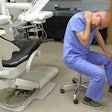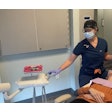Patients may not be the only ones to get anxious at dental practices. Clinicians experience performance anxiety when performing certain procedures, according to a study recently published in the Journal of Oral and Maxillofacial Surgery.
The anxiety levels of clinicians rose when oral and maxillofacial surgical procedures, including temporomandibular joint surgery, were performed, the authors wrote.
"Developing targeted anxiety management strategies is important, especially for procedures with high anxiety levels, such as temporomandibular joint surgery and bilateral sagittal split ramus osteotomy," wrote the authors, led by Dr. Onur Odabasi, an assistant professor at Ankara Yildirim Beyazit University in Turkey (J Oral Maxillofac Surg, February 5, 2025).
Surgical procedures can give surgeons some level of performance anxiety. However, it's not clear whether some procedures affect clinicians' self-perceived levels of anxiety.
It's important to manage excessive stress and anxiety because they can negatively affect surgeons' cognitive and motor skills, as well as their communication abilities, thereby possibly reducing operation success and affecting patient outcomes, according to the study.
To explore the association between different oral and maxillofacial surgical procedures and anxiety levels, a retrospective cross-sectional survey was conducted among oral and maxillofacial surgeons in Turkey.
The primary predictor variable was these procedures: simple and complex tooth extraction, impacted mandibular and maxillary canine premolar extraction, impacted mandibular and maxillary third-molar extraction, dental implant surgery, sinus lifting, simple and complex grafting cyst operations, Le Fort I surgery, sagittal split ramus osteotomy, genioplasty, and temporomandibular joint surgery.
Surgeons self-reported their anxiety levels. Of the 96 responses, 34 were women and 62 were men, according to the study.
Clinicians' anxiety levels differed considerably by surgical procedure (p < 0.001). The greatest levels of anxiety were seen during temporomandibular joint surgery (8.10 ± 2.23) and bilateral sagittal split ramus osteotomy (7.26 ± 2.49). However, the lowest anxiety levels were observed during tooth extraction (1.44 ± 1.86) and surgical tooth extraction (2.06 ± 2.04), the authors wrote.
Nevertheless, the study had shortcomings. Self-reported anxiety level raises the risk of recall bias, they wrote.
To handle performance anxiety, surgeons may want to consider employing strategies, including taking breaks between operations, using relaxation techniques, and creating detailed preoperative plans to boost their confidence, the authors wrote.
"The findings suggested that procedures that are technically challenging and carry higher risks, such as temporomandibular joint surgery and bilateral sagittal split ramus osteotomy, result in the highest anxiety levels among surgeons," Odabasi and co-author Mehmet Emrah Polat wrote.




















